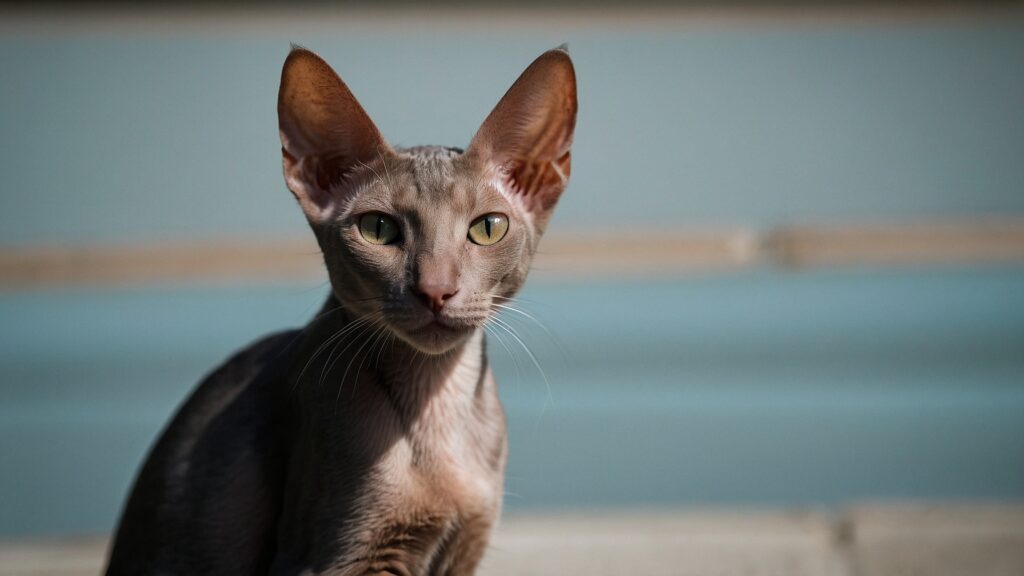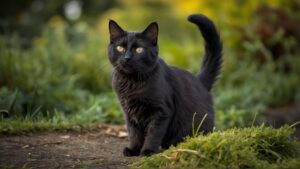As cat lovers, we’re often drawn to the unique features that make each breed special. While some felines are prized for their sleek coats or striking eye colors, others stand out for their distinctively large, expressive ears. These whiskered wonders not only charm us with their adorable looks but also boast evolutionary advantages thanks to their oversized auditory assets.
In this comprehensive article, we’ll embark on a journey through the fascinating world of cat breeds with big ears, uncovering the reasons behind their oversized auditory appendages and introducing you to some of the most popular and captivating large-eared felines. Get ready to fall head over heels for these charming companions!
Table of Contents
Why Do Some Cat Breeds Have Big Ears?
Before we dive into the specific breeds, it’s essential to understand why some cats have evolved to have larger ears than others. There are several reasons for this:
- Evolutionary Advantage for Hunting: In the wild, cats relied on their keen sense of hearing to locate and hunt prey successfully. Larger ears provided an evolutionary edge by enhancing their ability to pinpoint the slightest sounds, giving them an upper hand in the hunt.
- Heat Dissipation: Cats, being relatively small mammals, have a higher surface area-to-volume ratio than larger animals. This means they need to dissipate heat more efficiently. Larger ears with more surface area can help regulate body temperature by releasing excess heat.
- Genetic Mutations: In some cases, genetic mutations have led to the development of larger ears in certain cat breeds. These mutations were sometimes favored and preserved because of their unique appearance or potential functional benefits.
While bigger ears can offer advantages, it’s important to note that extreme ear sizes or shapes may also come with potential health risks or challenges, which we’ll discuss later in the article.
Top Cat Breeds with Big Ears
Now that we understand the reasons behind big ears in cats, let’s explore some of the most popular and captivating breeds that flaunt this distinctive feature:
Oriental

The Oriental breed is known for its distinctive “batted ear” look, with large, wide-based ears that taper to pointed tips. These ears, combined with their sleek, athletic bodies, give Orientals an elegant yet mischievous appearance that perfectly matches their curious and active personalities. Originating from Thailand, the Oriental is one of the oldest cat breeds and has been prized for centuries.
Donskoy
The Donskoy is a relatively rare breed that originated in Russia. These cats are known for their unique, hairless appearance and large, batted ears that give them a striking, almost extraterrestrial look. Despite their lack of fur, Donskoys are affectionate and social felines that make wonderful companions.
Bambino
The Bambino is a relatively new hybrid breed, developed in the United States by crossing a Sphynx and a Munchkin. These cats are characterized by their large, upright ears and a compact body, giving them a unique and endearing appearance. Bambinos are known for their playful and affectionate personalities, making them great companions for families or individuals alike.
Ukrainian Levkoy
The Ukrainian Levkoy is a rare breed that originated in Ukraine. These cats are known for their distinctive folded ears, similar to the Scottish Fold, but with a unique twist – their ears are folded forward, giving them a charming, quirky appearance. Ukrainian Levkoys are known for their affectionate and social nature, making them great companions for families.
Singapura
The Singapura is a small, compact breed that originated in Singapore. These cats are known for their large, pointed ears and striking ticked coat, which gives them a unique and striking appearance. Singapuras are known for their lively, curious personalities and make great companions for those who can keep up with their active lifestyles.
Chausie
The Chausie is a relatively new breed that was developed by crossing a domestic cat with a jungle cat. These cats are known for their large, pointed ears and their striking, wild appearance. Chausies are known for their athletic and energetic personalities, and they require experienced owners who can provide them with the attention and enrichment they need.
Egyptian Mau
The Egyptian Mau is an ancient breed that originated in Egypt. These cats are known for their large, moderately pointed ears and their striking, spotted coat. Egyptian Maus are known for their intelligence and their active, playful personalities, and they make great companions for those who can provide them with plenty of mental and physical stimulation.
Russian Blue
The Russian Blue is a stunning breed that originated in Russia. These cats are known for their large, pointed ears and their beautiful, plush blue-gray coat. Russian Blues are known for their intelligence and their calm, affectionate personalities, making them great companions for families or individuals alike.
Peterbald
The Peterbald is a rare breed that originated in Russia. These cats are known for their unique, hairless appearance and their large, cupped ears that give them a striking, almost extraterrestrial look. Peterbalds are known for their affectionate and social personalities, and they make great companions for those who don’t mind their lack of fur.
Cornish Rex
The Cornish Rex is a unique breed that originated in Cornwall, England. These cats are known for their large, bat-like ears and their curly, wavy coat. Cornish Rexes are known for their intelligence and their playful, energetic personalities, and they make great companions for those who can keep up with their active lifestyles.
Devon Rex
The Devon Rex is a close relative of the Cornish Rex, and they share many of the same unique features, including large, low-set ears and a curly, wavy coat. Devon Rexes are known for their intelligence and their playful, curious personalities, and they make great companions for those who can provide them with plenty of mental and physical stimulation.
Balinese
The Balinese is a beautiful breed that is closely related to the Siamese. These cats are known for their large, pointed ears and their striking, long-haired coat. Balinese cats are known for their intelligence and their affectionate, social personalities, and they make great companions for families or individuals alike.
Abyssinian
The Abyssinian is an ancient breed that originated in Ethiopia. These cats are known for their large, moderately pointed ears and their striking, ticked coat. Abyssinians are known for their intelligence and their active, playful personalities, and they make great companions for those who can provide them with plenty of mental and physical stimulation.
Snowshoe
The Snowshoe is a relatively new breed that originated in the United States. These cats are known for their large, pointed ears and their striking, white-and-colored coat pattern. Snowshoes are known for their intelligence and their affectionate, social personalities, and they make great companions for families or individuals alike.
Javanese
The Javanese is a breed that is closely related to the Balinese and the Siamese. These cats are known for their large, pointed ears and their sleek, colorful coat. Javanese cats are known for their intelligence and their affectionate, social personalities, and they make great companions for families or individuals alike.
Korat
The Korat is an ancient breed that originated in Thailand. These cats are known for their large, pointed ears and their striking, blue-gray coat. Korats are known for their intelligence and their calm, affectionate personalities, and they make great companions for families or individuals alike.
Siamese
The Siamese is one of the most well-known and popular breeds of cats in the world. These cats are known for their large, pointed ears and their striking, colorful coat pattern. Siamese cats are known for their intelligence and their affectionate, social personalities, and they make great companions for families or individuals alike.
Sphynx
The Sphynx is a unique breed that is known for its hairless appearance and large, batted ears. These cats have a striking, almost extraterrestrial look that is sure to turn heads. Sphynxes are known for their affectionate, social personalities, and they make great companions for those who don’t mind their lack of fur.
Ocicat
The Ocicat is a relatively new breed that was developed by crossing a Siamese and an Abyssinian. These cats are known for their large, pointed ears and their striking, spotted coat pattern. Ocicats are known for their intelligence and their active, playful personalities, and they make great companions for those who can provide them with plenty of mental and physical stimulation.
Savannah
The Savannah is a relatively new breed that was developed by crossing a domestic cat with a serval, a medium-sized wild cat. These cats are known for their large, pointed ears and their striking, wild appearance. Savannahs are known for their intelligence and their active, energetic personalities, and they require experienced owners who can provide them with the attention and enrichment they need.
As you can see, the world of cat breeds with big ears is vast, diverse, and endlessly fascinating. Each breed has its own unique charms, from their striking appearances to their endearing personalities. Whether you’re drawn to the whimsical Scottish Fold, the elegant Oriental, or the quirky Donskoy, there’s a big-eared feline friend out there to capture your heart.
Do Big Ears Affect a Cat’s Hearing?
One common question that arises when discussing cat breeds with big ears is whether their larger auditory appendages actually enhance their hearing abilities. The answer is generally yes – larger ears can provide a few distinct advantages:
- Increased Surface Area: More surface area on the ear means more space to capture and funnel sound waves towards the inner ear, potentially improving overall hearing sensitivity.
- Better Sound Localization: The larger the ears, the better a cat can pinpoint the location of sounds by detecting subtle differences in the timing and intensity of sound waves reaching each ear.
- Evolutionary Adaptation: Many large-eared breeds have evolved to have enhanced hearing capabilities, which aided their survival as hunters in the wild.
However, it’s important to note that extremely large or heavy ears can also pose some downsides. Excessive ear weight or size can strain the muscles and structures that support the ears, potentially leading to drooping or other issues over time.
As with any physical trait, responsible breeding practices and regular veterinary check-ups are essential to ensure the health and well-being of cats with big ears.
Caring for a Cat with Big Ears
While big ears can be adorable and offer potential benefits, they also require some extra care and attention. Here are some tips for caring for a cat with larger-than-average ears:
- Regular Ear Cleaning: Due to their increased surface area, big ears can accumulate more dirt, wax, and debris, increasing the risk of ear infections. Gently cleaning your cat’s ears with a vet-approved solution and following proper techniques is crucial.
- Checking for Ear Mites: Ear mites are a common problem in cats, and big ears can provide more hiding spaces for these pesky parasites. Regular inspections and prompt treatment are essential.
- Protecting Ears During Grooming: Big ears can be more prone to accidental nicks or cuts during grooming sessions, especially if your cat is prone to squirming. Take extra care or consider enlisting the help of a professional groomer.
- Monitoring for Ear Infections: Due to their unique ear shapes or sizes, some big-eared breeds may be more susceptible to ear infections or other ear-related issues. Regularly monitoring for signs of discomfort, inflammation, or discharge is crucial.
By taking proper precautions and providing attentive care, you can ensure that your big-eared feline friend stays happy, healthy, and comfortable.
Big Ears, Big Personality?
While there’s no definitive correlation between ear size and personality, many breeds with big ears are known for their social, curious, and lively temperaments. This could be due to a few potential factors:
- Heightened Awareness: With their enhanced hearing abilities, big-eared cats may be more attuned to the sounds and movements around them, making them appear more alert and reactive.
- Breed Characteristics: Some of the breeds known for their big ears, like the Oriental, were selectively bred for their outgoing, people-oriented personalities, which could contribute to their lively demeanors.
- Individual Differences: At the end of the day, each cat is an individual, and their personality is influenced by a complex interplay of genetics, environment, and socialization.
However, it’s important to remember that generalizations about personality should be taken with a grain of salt. While big ears may contribute to a cat’s overall demeanor, their individual temperament is ultimately shaped by a variety of factors, and responsible owners should be prepared to provide love, patience, and proper care regardless of their cat’s ear size or breed.
Conclusion
Cat breeds with big ears are not only visually striking but also offer fascinating evolutionary and functional advantages. From the whimsical Scottish Fold to the elegant Oriental, the charming American Curl, and the captivating Donskoy, Bambino, and Ukrainian Levkoy, these feline friends showcase the incredible diversity and beauty of the cat world.
When considering adopting a big-eared breed, it’s crucial to research their specific needs, temperaments, and potential health concerns. With proper care and attention, these cats can make wonderful, loving companions that will undoubtedly bring joy and laughter into your life with their adorable antics and expressive ears.
So, if you’re smitten by the idea of having a cat with big, beautiful ears, start your research today and get ready to welcome one of these whiskered wonders into your home!
FAQs
Are big ears a sign of good hearing in cats?
Generally, yes. Larger ears can enhance a cat’s hearing ability by increasing the surface area for capturing sound waves and improving sound localization. However, extremely large or heavy ears may also pose some downsides, so moderation is key.
Can big ears cause health problems in cats?
While big ears themselves are not inherently problematic, some breeds with distinctive ear shapes or sizes may be more prone to ear infections, mites, or other ear-related issues. Responsible breeding practices and regular veterinary check-ups are essential for maintaining ear health.
Do all big-eared cats have similar personalities?
Not necessarily. While some big-eared breeds, like the Oriental and American Curl, are known for their social and lively temperaments, each cat is an individual, and their personality is influenced by a complex interplay of genetics, environment, and socialization.
Can I adopt a big-eared cat if I live in an apartment?
Absolutely! Many big-eared breeds can thrive in apartment living as long as their exercise, mental stimulation, and social needs are met. Proper research and preparation are key to ensuring a happy, healthy living environment for your feline friend.
How do I properly care for a cat with big ears?
Caring for a big-eared cat involves regular ear cleaning, checking for ear mites or infections, protecting the ears during grooming, and monitoring for any signs of discomfort or inflammation. Seeking guidance from a veterinarian is recommended for proper ear care techniques.
Reference
- Cat Breeds by TICA https://www.tica.org/breeds/browse-all-breeds




